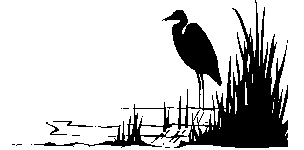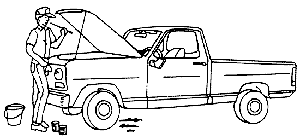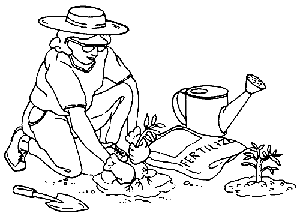|
for information on |
|
reporting dumping |
|
and/or illicit
discharges |

|
1. Can car or truck wastes be carried away by stormwater?
|
1a. Choose the answer that best describes how you handle automotive wastes. a. Oil drips and fluid spills are cleaned up. Dirty car parts and other vehicle wastes are kept from stormwater runoff. b. Drips and spills are not cleaned up. Car parts and other vehicle wastes are left on unpaved areas outside. c. Used oil, antifreeze, and other wastes are dumped down the storm drain, in a ditch, or on the ground. |
| Oil stains on your driveway and outdoor spills of antifreeze, brake fluid, and other automotive fluids are easily carried along the stormwater superhighway during a rainstorm. An oily sheen on runoff from your driveway is a sure sign that you need to be more careful. Pans, carpet scraps, and matting can catch drips. Routine maintenance can prevent your car from leaking | |
|
and help identify potential leaks. If you change your own oil, be careful to avoid spills and collect waste oil for recycling. Store oily car parts and fluid containers where rain and runoff cannot reach them. NEVER DUMP used oil, antifreeze, or gasoline down a storm drain, in a ditch, or on the ground. | |
|
These wastes will end up in a nearby lake or stream, or they may pollute your drinking water. Washing your car in the driveway creates runoff without the help of a rainstorm - your hose provides the water. The dirty, soapy runoff drains directly into storm drains, picking up oil and other pollutants as it goes. If possible, try washing your car on your lawn. Better yet, take it to a commercial car wash that sends its dirty water to a wastewater treatment plant. |
1b. Choose the answer that best describes how you wash your car. a. Cars and trucks are taken to a commercial car wash that sends its water to a wastewater treatment plant. b. Cars, trucks, or other vehicles are washed on a lawn or gravel drive. c. Cars, trucks, or other vehicles are washed on a driveway, street, or other paved area. |
2. Do you
store household products outside the reach of
stormwater? |
2. Choose the answer that best describes how you store pesticides, fertilizers, and other potentially harmful chemicals. a. Chemicals are stored in waterproof containers in a garage, shed, or basement that is protected from stormwater. b. Chemicals are stored in waterproof containers but within reach of stormwater. c. Chemicals are stored in non - waterproof containers outdoors or within reach of stormwater. |
| Most people have lawn and garden products like herbicides, insecticides, fungicides, and fertilizers. If stormwater or floodwater reaches these products, it can transport them into surface waters and possibly your well. | |
| Pool chemicals, salt for water softners, and a wide variety of other chemical products are also troublesome pollutants if they wash into stormwater runoff. Keeping such products in waterproof containers and storing them up high and out of the potential path of runoff or floods is important. You can avoid storage problems by buying only as much of a product as you need for a particular task. | |
|
3. Do you use and handle chemicals safely? Safe storage is only the first step in preventing contaminated runoff. Mix chemicals within a washtub so spills will be contained. If you do spill chemicals, act quickly to contain and clean up the spill. This is particularly important on paved surfaces. Using more pesticides or fertilizers than you need invites problems. Timing of applications is also important. DO NOT apply lawn and garden chemicals if rain is expected within 24 hours. |
3. Choose the answer that best describes how you
handle and use pesticides, fertilizers, and other lawn and garden
chemicals.
a. Spills are cleaned up immediately, particularly on paved surfaces. Minimum amounts of chemicals are applied according to label instructions. Applications are timed to avoid rain. b. Spills are cleaned up immediately, particularly on paved surfaces. Minimum amounts of chemicals are applied according to instructions. Applications are NOT timed to avoid rain. c. Spills are not cleaned up. Products are used in higher amounts than is recommended on the label. |
|
4. How do you keep animal wastes from becoming a pollution problem?
Droppings from dogs, cats, and other commonly kept animals, such as exotic birds, rabbits, goats, horses, and chickens, can be troublesome in two ways. First, pet wastes contain nutrients that can promote the growth of algae if wastes enter streams, lakes, and estuaries. Second, animal droppings contain bacteria that can cause disease. The risk of stormwater contamination increases if pet wastes are allowed to accumulate in animal pen areas or left on sidewalks, streets, driveways, or drainage ways from which they can be carried along the stormwater system to water bodies. Instead of allowing pet wastes to accumulate or sending them to a landfill, consider flushing the wastes down the toilet or burying them. |
4. Choose the answer that best describes how you handle pet and animal wastes. a. Animal and pet wastes are flushed down the toilet; buried away from rivers,streams, ditches; or wrapped and placed in the garbage for disposal. b. Animal wastes are left to decompose on grass or soil. Wastes are scattered over a wide area. c. Animal wastes are left on paved surfaces, concentrated in pen or yard areas, or dumped down a storm drain or in a ditch. |
|
5. Do you keep yard and garden wastes out of stormwater?
|
5. Choose the answer that best describes how you handle grass clippings, leaves, and other yard waste. a. Grass clippings, leaves, and other yard wastes are swept off paved surfaces and onto lawns away from water flow routes. Leaves and other yard wastes are composted. b. Leaves and other yard wastes are piled on the lawn next to the street for collection. c. Grass clippings, leaves, and other yards wastes are left on driveways, streets, and other paved areas to be carried off by stormwater. And/or yard waste is burned on - site. |
|
If left on sidewalks, driveways, or roads, grass clippings and other yard wastes will wash away with the next storm. Although leaves and other plant debris accumulate naturally in streams and lakes, homeowners can contribute excess amounts of plant matter, especially in areas with many homes. This can lead to water that is unattractive or green with algae, potential fish kills, and make areas unsuitable for recreation. Burning yard waste is not an environmentally friendly alternative - and in some areas it's illegal. Hydrocarbons and nutrients released by burning leaves contribute to water pollution as well as to air pollution. Rain washes smoke particles out of the air, and runoff picks up dust and ashes left on pavement or in ditches. Avoiding the problem is easy: sweep clippings back onto the grass, and compost leaves and garden wastes on you property to recycle nutrients. | |
|
6. Are there areas of bare soil around your home?
|
6a. Choose the answer that best describes the bare soil in your lawn or garden. a. Bare spots in the lawn are promptly seeded and topped with a layer of straw or mulch. Bare soil in gardens is covered with mulch. b. Grass or other ground cover is spotty, particularly on slopes. c. Spots in the lawn or garden are left exposed without mulch or vegetation for long periods. |
|
Areas of bare soil often exist in vegetable and flower gardens, on newly seeded lawns, and around construction projects. Even on gentle slopes, water from rain and snow can remove large amounts of soil and carry it to wetlands, lakes, streams, and estuaries. Planting grass or other groundcovers is the best way to stop erosion. Putting a straw or chip mulch over gardens or newly seeded areas will slow erosion. Straw bales, diversion ditches, and commercially available silt fences placed around construction sites can help slow runoff and trap sediment on - site. Construction activities (clearing, grading, and/or excavation) can significantly increase and accelerate erosion. To prevent erosion and sediment from entering the storm drain system, exposed areas should be stabilized as quickly as possible. Minimize disturbance and soil exposure by retaining natural vegetation, adopt phased construction techniques, and use temporary cover. Once grading activities are completed, plant temporary/permanent vegetation or other erosion control measures as soon as possible. |
|
|
Use compacted, vegetated earthen dikes, pipes, or other stable drainage structures to minimize erosion by diverting off-site runoff around or through the construction site. If erosion generated by runoff from cleared areas of the construction site cannot be prevented, trap, and filter sediment to stop eroded soil and debris from being carried off site. Place suitable barriers such as sandbags, hay bales, or silt fences at the following locations:
|
6b. Choose the answer that best describes how you handle bare soil during construction. a. Bare soil is seeded and mulched as soon as possible (before construction is completed). Sediment traps and filters are used until grass covers soil. b. Soil is left bare until construction is completed. Sediment traps and filters are installed and maintained to detain muddy runoff until grass covers soil. c. Soil is left bare and no sediment traps or filters are used. |
|
7. Can you eliminate paved surfaces or install alternatives? Concrete and asphalt roads, driveways, and walkways are impervious; they prevent rainwater from soaking into the ground. When you have the choice, consider alternative materials such as gravel or wood chips for walkways. Avoid paving areas like patios. Where you need a more solid surface, consider using a "porous pavement" made from interlocking cement blocks, hard plastic grids filled with stone or earth, or rubber mats that allow spaces for rainwater to seep into the ground. If you must pour concrete, keep the paved areas as small and narrow as possible. |
7. Choose the answer that best describes your use of paved surfaces. |
|
a. Paved surfaces are minimized. Alternatives such as wood chips or paving blocks are used for walkways, patios, and other areas. b. Some small areas are paved for patios or basketball. c. Paved surfaces are used extensively. | |
|
8. Does your roof water flow onto pavement or grass? Your house roof, like pavement, concentrates rain water into stormwater runoff. If downspouts from roof gutters empty onto grassy or natural areas, the water will have a chance to soak into the ground. Aim downspouts away from foundations and paved surfaces. For roofs without gutters, plant grass, spread mulch, or use gravel under the drip line to prevent soil erosion and increase infiltration of water into the ground. Consider using cisterns or rain barrels to catch rain for watering your lawn and garden in dry weather. |
|
|
8. Chose the answer that best describes how you handle roof drainage. a. Downspouts and drip lines direct roof drainage onto a lawn or garden where water soaks into the ground. b. Some downspouts and drip lines discharge water onto paved surfaces or grassy areas where water runs off. c. Most or all drip lines or downspouts discharge onto paved surfaces, or downspouts are connected directly to storm drains. | |
|
9. Can you change the layout of your landscape to reduce runoff? An essential part of stormwater management is keeping water on your property, or at least slowing down its flow as much as possible. Many lawns are sloped to encourage water to runoff onto neighboring property or streets. An alternative approach is to create rain gardens (described in the following section). If your yard is hilly, you can terrace slopes to slow the flow of runoff. If you have a large lot, consider "naturalizing" areas with woodland or wetland plants. If your property adjoins a lake or stream, one of the best ways to slow and filter runoff is to leave a buffer strip of thick vegetation along the waterfront, which is called a riparian buffer. |
9. Choose the answer that best describes how you use landscaping and buffer strips. |
| a. Yard is landscaped to slow the flow of
stormwater and utilize rain gardens. Unmowed buffer strips of thick
vegetation are left along streams or lake shores.
b. No areas are landscaped to encourage water to soak in, but yard is relatively flat and little runoff occurs. Mowed grass or spotty vegetation exists adjacent to a stream or lake. c. There is no landscaping to slow the flow of stormwater, especially on hilly, erodible properties. Stream banks or lake shores are eroding. | |
|
10. Are rain gardens appropriate? Often runoff can be diverted to localized low spots in your yard. These areas, when planted with water-tolerant vegetation such as redbuds, st. john's wort, cherrybark oak, and sweet pepperbush, are called rain gardens. Rain gardens naturally filter water and provide an effective means for putting surface water back into groundwater. |
10. Choose the answer that best describes how you divert stormwater runoff. |
|
a. Stormwater is diverted to engineered rain gardens in low - lying areas of your yard. Water is routed into and out of rain gardens. b. Stormwater is diverted to low areas without appropriate measures taken to make sure water will leave the site. c. Runoff leaves the yard without any treatment. | |
| How did you do? |
Grade
Scale |
|
Chose answer a for 8 - 10 of the
questions: |
Excellent |
|
Chose answer a for 5 - 7 of the
questions: |
Room for Improvement |
|
Chose answer a for 4 or less of the
questions: |
Need work |
|
|
|
|
Last Updated June 3, 2002 | |||||||
|
| |||||||
 Website developed by Ventura County Watershed Protection
District Website developed by Ventura County Watershed Protection
District | |||||||




 REMINDER: If you chose answers b or c
for any question, you may be causing water pollution.
REMINDER: If you chose answers b or c
for any question, you may be causing water pollution.